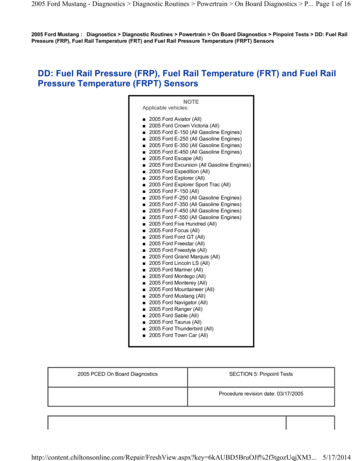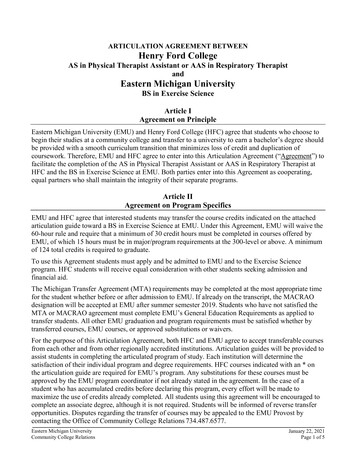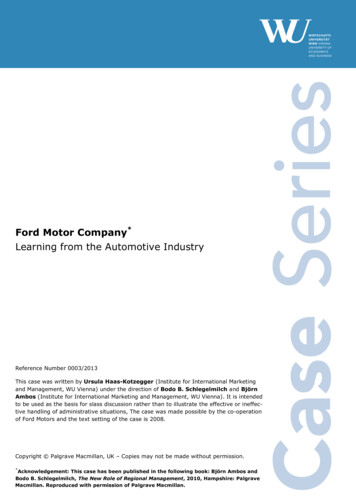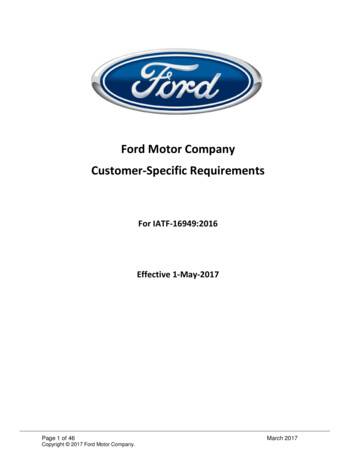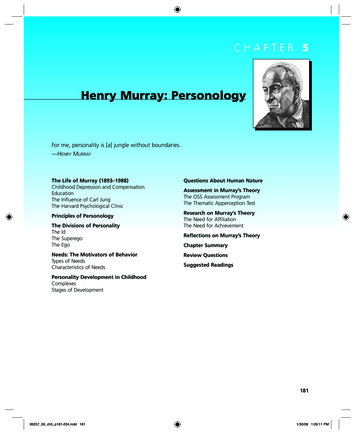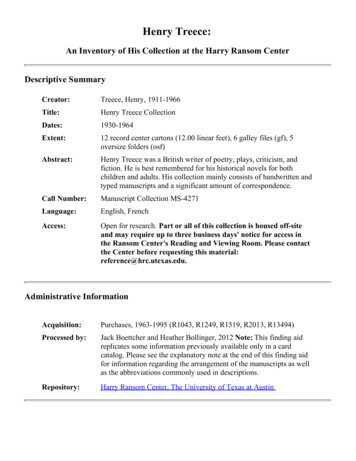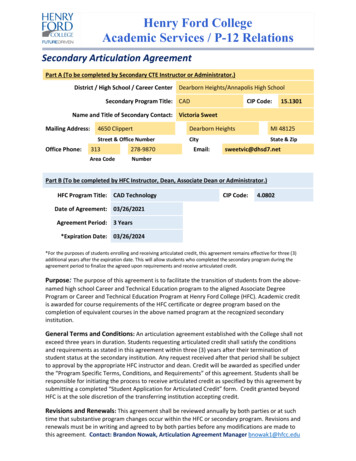
Transcription
Henry Ford CollegeAcademic Services / P-12 RelationsSecondary Articulation AgreementPart A (To be completed by Secondary CTE Instructor or Administrator.)District / High School / Career Center Dearborn Heights/Annapolis High SchoolSecondary Program Title: CADCIP Code:15.1301Name and Title of Secondary Contact: Victoria SweetMailing Address:Office Phone:4650 ClippertDearborn HeightsMI 48125Street & Office NumberCityState & Zip313278-9870Area CodeNumberEmail:sweetvic@dhsd7.netPart B (To be completed by HFC Instructor, Dean, Associate Dean or Administrator.)HFC Program Title: CAD TechnologyCIP Code:4.0802Date of Agreement: 03/26/2021Agreement Period: 3 Years*Expiration Date: 03/26/2024*For the purposes of students enrolling and receiving articulated credit, this agreement remains effective for three (3)additional years after the expiration date. This will allow students who completed the secondary program during theagreement period to finalize the agreed upon requirements and receive articulated credit.Purpose: The purpose of this agreement is to facilitate the transition of students from the abovenamed high school Career and Technical Education program to the aligned Associate DegreeProgram or Career and Technical Education Program at Henry Ford College (HFC). Academic creditis awarded for course requirements of the HFC certificate or degree program based on thecompletion of equivalent courses in the above named program at the recognized secondaryinstitution.General Terms and Conditions: An articulation agreement established with the College shall notexceed three years in duration. Students requesting articulated credit shall satisfy the conditionsand requirements as stated in this agreement within three (3) years after their termination ofstudent status at the secondary institution. Any request received after that period shall be subjectto approval by the appropriate HFC instructor and dean. Credit will be awarded as specified underthe “Program Specific Terms, Conditions, and Requirements” of this agreement. Students shall beresponsible for initiating the process to receive articulated credit as specified by this agreement bysubmitting a completed “Student Application for Articulated Credit” form. Credit granted beyondHFC is at the sole discretion of the transferring institution accepting credit.Revisions and Renewals: This agreement shall be reviewed annually by both parties or at suchtime that substantive program changes occur within the HFC or secondary program. Revisions andrenewals must be in writing and agreed to by both parties before any modifications are made tothis agreement. Contact: Brandon Nowak, Articulation Agreement Manager bnowak1@hfcc.edu
Henry Ford CollegeAcademic Services / P-12 RelationsSecondary Articulation AgreementProgram Specific Terms, Conditions, and RequirementsPart C (To be completed by HFC Instructor, Dean, Associate Dean or Administrator.)HFC Program Title: CAD TechnologyCIP Code:04.0802(The space below is used by HFC instructors, Faculty Chair or Administrators to specify secondary articulationagreement terms, conditions, and requirements for the above program.)1.Students must achieve a “C” or better average for each applicable class taken at DearbornHeights/Annapolis High School that may apply to the specified program at Dearborn Heights/AnnapolisHigh School.2.Students must have demonstrated a good/satisfactory attendance record for the course/program atDearborn Heights/Annapolis High School.3.Students from Dearborn Heights/Annapolis High School must demonstrate competency in each course,for which HFC will grant articulated credit, as determined by HFC Faculty.4.The secondary articulation agreement is predicated on relevant course/program curriculum submittedby Dearborn Heights/Annapolis High School and reviewed/evaluated by HFC Staff.5.Secondary articulated credit will be held in escrow for:DRAF 110 Into to Industrial DraftingDRAF 120 Intro to CADTotal3 CR4 CR7 CRCredit will be awarded upon completion of the following HFC course(s) with a grade of “C” or better:DRAF 130Technical Descriptive Geometry 3 CRTotal3 CRSecondary Instructor or Administrator Name and Title:Printed NamePrinted TitleAuthorizing Signatures:Secondary Instructor or AdministratorDateHFC Instructor or Faculty ChairDate
Annapolis High School4650 ClippertDearborn Heights, MI 48125313-203-3300School Year:2020-21Course Name:Drafting & Design/CADCourse Number:735Course Credit:One Year Program – (Two Hour Session – Two Semester/3 Credits)Instructor:Mrs. SweetCourse Description: This course is designed for a variety of students who may have differentcareer paths in mind. It will serve as an excellent foundation for those who would like to obtain entrylevel employment in the drafting and computer aided design (CAD) industry, or perhaps continuetoward a degree in the technical or engineering fields. Students will focus on learning state of the artCAD software by working on architectural, mechanical and manufacturing projects. They will alsodesign and create vinyl decals using industry equipment. Students take part in the State of Michigancivil engineering curriculum which includes competitions and potential paid internships. Collegecredit through “articulation” can be obtained at HFCC.Course Objectives: Students will draw architectural, civil and mechanical plans. Through thiscourse students will receive an understanding of the architectural fields and the related career fields.Student Competencies:A23459C3491011K12345LIntroduction to DraftingIdentify ANSI and other standards and codesDevelop an understanding of the industry (e.g. permanence, value, and relevance of work)Identify the various occupationsDemonstrate organizational skills (e.g. record-keeping procedures)Produce copies (e.g. blueline and blackline)Basic Computer SkillsUse the InternetUse scanning equipment and softwareInstall and configure software and hardware (e.g. plotter)Operate and customize input devicesOperate and customize output devicesApplied Mathematical SkillsDemonstrate basic math principlesSolve problems using formulasSolve problems using algebraSolve problems using geometrySolve problems using trigonometryBasic CAD Skills
2345678910Use query commands to extract drawing dataPlot drawings to the proper scaleApply scaling techniquesUse the Line-Type (LT) scaleUse Cartesian coordinatesAdvanced CAD SkillsUse the Internet and/or network within CAD (e.g. team projects)Create 3-D assembliesCreate and edit a solid modelUse various software programs to produce a productDemonstrate an understanding of modelsUse geometry in parametric programsCreate 2-D geometry form 3-D modelsExtract surface and mass properties (e.g. area and perimeter)Import and export various file formats (e.g. BXF,IGES, and rost)Perform customization to improve productivityIntroduction to Architectural DrawingsProduce elevation drawingsConstruct architectural symbolsProduce floor plansIdentify architectural design and planning principlesIdentify basic construction terminology and materialsUse perspectives and pictorialsProduce typical wall and building sections with necessary detailsIdentify applicable building codesMeasure, sketch, and draft an as-built floor planPrepare a schedule using a freehand architectural style letteringProduce a site planProduce a foundation planIntroduction to Residential and Commercial Wiring DrawingsIdentify applicable codes (e.g. IEC, NEC, and IEEE)Identify electrical symbolsProduce wiring schematicsIntroduction to Civil/GIS (Geographic Information Systems) DrawingsDemonstrate land surveying techniques (e.g. property line, corn ers, symbols, coordinates,base line, and typical sections)Identify the uses of GIS and Global Positioning Systems (GPS)Produce a land survey plot from a written descriptionFigure the area using manual and computer methodsProduce a contour planProduce a profile drawingDemonstrate map reading skillsDemonstrate map drawing skillsLeadership Competencies **Demonstrate an understanding of SkillsUSA-VICA, its structure,Demonstrate an understanding of one’s personal valuesPerform tasks related to effective personal management skillsDemonstrate interpersonal skillsDemonstrate etiquette and courtesyDemonstrate effectiveness in oral and written communicationDevelop and maintain a code or professional ethicsMaintain a good professional appearancePerform basic tasks related to securing and terminating employeesPerform basic parliamentary procedures in a group meeting(Note: Refer to 15.1301 CIP code for the entire list)
Required Text: Architecture Residential Drafting and Design by Clois KicklighterReferences & Other Resources: Students will have access to the Internet, AutoCAD, and MediaCenterCourse Outline: Introduction to Drafting, Basic Computer Skills, Applied Mathematical Skills, BasicCAD Skills, Advanced CAD Skills, Introduction to Architectural Drawings, Introduction to Residentialand Commercial Wiring Drawings, Introduction to Civil/GIS (Geographic Information Systems)Drawings, Leadership CompetenciesClass Assignments: Students will work alone and in groups solving design problems whichnormally require drawing reports and research.Final Exam: Students will have a written and drawing exam. The exam will be cumulative exam forthe tri-mesterClass Policies:Rules:1.2.3.4.5.6.No accessing Internet without teacher approvalNo copying of other student files.No food, beverage, or gum in the labComputers are to be used in accordance with the technology use agreementNo horseplay or inappropriate verbal communication.No electronic entertainment devices or cell phonesStudent Responsibilities:1. Attendance - Consistent attendance is a must. Students must be in class and on time.2. Materials - Students will be expected to bring all materials to class to effectively utilize classtime and to turn in all work in a timely manner.3. Entering the classroom – Come into the classroom quietly and take your seat. Check theboard for daily assignments and log on to the computer system.4. Work Habits – Demonstrate good work habits during the class. Work habits include:responsible, positive attitude, follow directions, safety, initiative, interest, efficiency, andcorporation.5. Dismissing at the end of the period – Dismissal will be at your workstations. Make sure thechair is pushed in, the computer is logged off, and the keyboard, mouse, and monitor arealigned with the desk.6. Returning to class after an absence – See the teacher7. Arriving tardy to class- Enter the classroom quietly, take your seat and quickly begin to getyour materials together and log into your computer. Don’t forget to check the board forassignments.8. Talking during class – Talking is permitted as long as you are quiet and it pertains to thesubject area.9. Asking for help – Before you ask the teacher a question make sure you referred to yournotes/book and have already experimented. Raise your hand and the teacher will assist.10. Moving about the room – Unless you are getting materials or receiving help students shouldnot be out of their seats.
11. Restroom – Unless it’s an emergency, all students should take advantage of the restroomsbetween classes.12. Emergency procedures - Fire and tornado procedures are posted in the classroom, pleasereview. In the event of an emergency follow the teachers’ instructionsEvaluation & Grading:The students will be evaluated on work habits, assignments, quizzes/tests, and portfolio.Computing grades:A 90% and aboveB 80% to 89%C 70% to 79%D 60% to 69%E 0% to 59%Semester Grade:Assignments, Portfolio,Work Habits 25%Quizzes & Tests 75%Assignments: All work that is assigned will be graded and returned to the students. Assignmentsinclude but are not limited to: drawings, presentations, & handouts.Quizzes & Tests: All quizzes and tests will reflect material or information that has been covered inclass. Academic dishonesty or cheating will not be tolerated and may result in a loss of credit for thequiz/test.Portfolio: All students will maintain a notebook that contains notes from class discussions and anyassigned drawings. This notebook will be turned in at periodic intervals during the semester asdirected by the teacher for a grade.Work Habits: Work Habits will be assessed throughout the tri-mester. Students will be able to earnpoints which will be a combination of attendance and performance in the class.Late Assignments: Students will turn in the projects on the due date. Whether the project iscomplete or not. The students will be assessed a grade according to work complete. No lateassignments will be permitted unless student was absent. Absent students will be have double theamount of days absent to turn in the work. If a student was absent for one day they will receive twodays to turn in the assignment.Course Advisory Committee: The advisory committee is made up of a variety of members frombusiness and industry, post-secondary, parents and former students.Articulation: Henry Ford College has partnered with Annapolis High School to provide articulationopportunities.Class Material: All students must obtain the following materials for use within the class: writingutensil, 2” notebook with clear cover on the front, & 25 sheet protectors.
Absent: Upon returning to the classroom it is your responsibility for work missed and receiving anyrequired notes. Make up work that requires the use of the classroom computers will requireconsultation with the teacher to determine if lab time is available.Work Based Learning: As a completer for the CAD program students will participate in a work baselearning experience.Work HabitsWork habits are meaningful. Employers have recognized valuable employees as those who demonstrate knowledge andskill in a chosen area plus have a positive attitude towards work. That's why work habits are a part of the final grade inthis course.1.RESPONSIBILITY AND DEPENDABILITY are indicatedwhen youa. are in class on time every dayb. report absences as requiredc. complete tasks on timed. return tools and equipment to the proper place5.INITIATIVE AND EFFORT are indicated when youa. complete routine tasks before being toldb. begin new tasks without being toldc. volunteer for extra duties or assignmentsd. ask for help when needede. complete extra tasks2.POSITIVE ATTITUDE is indicated when youa. contribute every dayb. accept constructive criticismc. are a leader and set a goods exampled. work willingly every daye. complete extra tasks6.INTEREST is indicated when youa. are in class on time every dayb. come prepared to workc. stay on taskd. work actively toward your career goal3.FOLLOWING DIRECTIONS is indicated when youa. follow program rulesb. follow verbal instructionsc. follow written instructions7.4.SAFETY is indicated when youa. use and store tools and equipment properlyb. maintain a safe work areaEFFICIENCY is indicated when youa. plan and organize your workb. conserve materialsc. complete tasks accuratelyd. recheck, verify, and proof worke. complete tasks on time8.COOPERATION is indicated when youa. participate activelyb. assist othersc. volunteer readilyd. respect people and propertye. encourage others
Annapolis High School4650 ClippertDearborn Heights, MI 48125313-203-3300School Year:2020-21Course Name:Mechanical 1A & 1BCourse Number:714/715Course Credit:Two Semesters – (1.0 Credits)Instructor:Mrs. SweetCourse Description: This class serves as an introduction course in computer aided draftingemphasizing on mechanical design techniques. During the class students will design mechanical,electronics, packaging design, civil design and 2D as well as 3D design. They will also design andproduce a vinyl decal, construct wooden models and enter into competitions.Course Objectives: Students will draw mechanical plans. Through this course students will receivean understanding of the mechanical fields and the related career fields.Student Competencies:15.1306 Mechanical Drafting Consolidated (2011)IACADEMIC FOUNDATIONSIICOMMUNICATIONSIIIPROBLEM-SOLVING AND CRITICAL THINKINGIVINFORMATION TECHNOLOGY APPLICATIONSVSYSTEMSVISAFETY, HEALTH AND ENVIRONMENTALVIILEADERSHIP AND TEAMWORKVIIIETHICS AND LEGAL RESPONSIBILITIESIXEMPLOYABILITY AND CAREER DEVELOPMENTXTECHNICAL SKILLSXIENGINEERING TECHNOLOGY PATHWAYRequired Text: Elementary Blueprint Reading for Machinist 4th Edition by David Taylor
References & Other Resources: Students will have access to the Internet, AutoCAD, and MediaCenterCourse Outline: Introduction to Drafting, Basic Drawing Skills, Basic Computer Skills, BasicCommunication Skills, Applied Mathematical Skills, Basic CAD SkillsClass Assignments: Students will work alone and in groups solving design problems whichnormally require drawing reports and research.Final Exam: Students will have a written and drawing exam. The exam will be cumulative exam forthe semesterClass Policies:Rules:1.2.3.4.5.6.No accessing Internet without teacher approvalNo copying of other student files.No food, beverage, or gum in the labComputers are to be used in accordance with the technology use agreementNo horseplay or inappropriate verbal communication.No electronic entertainment devices or cell phonesStudent Responsibilities:1. Attendance - Consistent attendance is a must. Students must be in class and on time.2. Materials - Students will be expected to bring all materials to class to effectively utilize classtime and to turn in all work in a timely manner.3. Entering the classroom – Come into the classroom quietly and take your seat. Check theboard for daily assignments and log on to the computer system.4. Work Habits – Demonstrate good work habits during the class. Work habits include:responsible, positive attitude, follow directions, safety, initiative, interest, efficiency, andcorporation.5. Dismissing at the end of the period – Dismissal will be at your workstations. Make sure thechair is pushed in, the computer is logged off, and the keyboard, mouse, and monitor arealigned with the desk.6. Returning to class after an absence – See the teacher7. Arriving tardy to class- Enter the classroom quietly, take your seat and quickly begin to getyour materials together and log into your computer. Don’t forget to check the board forassignments.8. Talking during class – Talking is permitted as long as you are quiet and it pertains to thesubject area.9. Asking for help – Before you ask the teacher a question make sure you referred to yournotes/book and have already experimented. Raise your hand and the teacher will assist.10. Moving about the room – Unless you are getting materials or receiving help students shouldnot be out of their seats.11. Restroom – Unless it’s an emergency, all students should take advantage of the restroomsbetween classes.12. Emergency procedures - Fire and tornado procedures are posted in the classroom, pleasereview. In the event of an emergency follow the teachers’ instructions
Evaluation & Grading:The students will be evaluated on work habits, assignments, quizzes/tests, and portfolio.Computing grades:A 90% and aboveB 80% to 89%C 70% to 79%D 60% to 69%E 0% to 59%Semester Grade:Assignments, Portfolio,Work Habits 25%Quizzes & Tests 75%Assignments: All work that is assigned will be graded and returned to the students. Assignmentsinclude but are not limited to: drawings, presentations, & handouts.Quizzes & Tests: All quizzes and tests will reflect material or information that has been covered inclass. Academic dishonesty or cheating will not be tolerated and may result in a loss of credit for thequiz/test.Portfolio: All students will maintain a notebook that contains notes from class discussions and anyassigned drawings. This notebook will be turned in at periodic intervals during the semester asdirected by the teacher for a grade.Work Habits: Work Habits will be assessed throughout the tri-mester. Students will be able to earnpoints which will be a combination of attendance and performance in the class.Late Assignments: Students will turn in the projects on the due date. Whether the project iscomplete or not. The students will be assessed a grade according to work complete. No lateassignments will be permitted unless student was absent. Absent students will be have double theamount of days absent to turn in the work. If a student was absent for one day they will receive twodays to turn in the assignment.Course Advisory Committee: The advisory committee is made up of a variety of members frombusiness and industry, post-secondary, parents and former students.Articulation: Henry Ford College has partnered with Annapolis High School to provide articulationopportunities.Class Material: All students must obtain the following materials for use within the class: writingutensil, 2” notebook with clear cover on the front, & 25 sheet protectors.Absent: Upon returning to the classroom it is your responsibility for work missed and receiving anyrequired notes. Make up work that requires the use of the classroom computers will requireconsultation with the teacher to determine if lab time is available.Work Based Learning: As a completer for the mechanical program students will participate in awork base learning experience.Work Habits
Work habits are meaningful. Employers have recognized valuable employees as those who demonstrate knowledge andskill in a chosen area plus have a positive attitude towards work. That's why work habits are a part of the final grade inthis course.1.RESPONSIBILITY AND DEPENDABILITY are indicatedwhen youa. are in class on time every dayb. report absences as requiredc. complete tasks on timed. return tools and equipment to the proper place5.INITIATIVE AND EFFORT are indicated when youa. complete routine tasks before being toldb. begin new tasks without being toldc. volunteer for extra duties or assignmentsd. ask for help when needede. complete extra tasks2.POSITIVE ATTITUDE is indicated when youa. contribute every dayb. accept constructive criticismc. are a leader and set a goods exampled. work willingly every daye. complete extra tasks6.INTEREST is indicated when youa. are in class on time every dayb. come prepared to workc. stay on taskd. work actively toward your career goal3.FOLLOWING DIRECTIONS is indicated when youa. follow program rulesb. follow verbal instructionsc. follow written instructions7.4.SAFETY is indicated when youa. use and store tools and equipment properlyb. maintain a safe work areaEFFICIENCY is indicated when youa. plan and organize your workb. conserve materialsc. complete tasks accuratelyd. recheck, verify, and proof worke. complete tasks on time8.COOPERATION is indicated when youa. participate activelyb. assist othersc. volunteer readilyd. respect people and propertye. encourage others
Annapolis High School4650 ClippertDearborn Heights, MI 48125313-203-3300School Year:2020-21Course Name:Mechanical 2A & 2BCourse Number:719/720Course Credit:Two Trimesters – (1.0 Credits)Instructor:Mrs. SweetCourse Description: This course is designed to further develop skills in visualization throughdrawings. This course will be taught using CAD software both 2D & 3D. Additional areas that will becovered are 3D assemblies, exploded assemblies, parametric modeling using Inventor software.Students will design and produce a 3D part using the 3D printer as well as vinyl decals. Competitionswill also be a part of the program. Students who enroll in this course must have successfullycompleted Mechanical Drafting I and II.Course Objectives: Students will draw mechanical plans. Through this course students will receivean understanding of the mechanical fields and the related career fields.Student Competencies:15.1306 Mechanical Drafting Consolidated (2011)IACADEMIC FOUNDATIONSIICOMMUNICATIONSIIIPROBLEM-SOLVING AND CRITICAL THINKINGIVINFORMATION TECHNOLOGY APPLICATIONSVSYSTEMSVISAFETY, HEALTH AND ENVIRONMENTALVIILEADERSHIP AND TEAMWORKVIIIETHICS AND LEGAL RESPONSIBILITIESIXEMPLOYABILITY AND CAREER DEVELOPMENTXTECHNICAL SKILLSXIENGINEERING TECHNOLOGY PATHWAYRequired Text: Elementary Blueprint Reading for Machinist 4th Edition by David Taylor
References & Other Resources: Students will have access to the Internet, AutoCAD, and MediaCenterCourse Outline: Introduction to Drafting, Basic Drawing Skills, Basic Computer Skills, BasicCommunication Skills, Applied Mathematical Skills, Basic CAD SkillsClass Assignments: Students will work alone and in groups solving design problems whichnormally require drawing reports and research.Final Exam: Students will have a written and drawing exam. The exam will be cumulative exam forthe semesterClass Policies:Rules:1.2.3.4.5.6.No accessing Internet without teacher approvalNo copying of other student files.No food, beverage, or gum in the labComputers are to be used in accordance with the technology use agreementNo horseplay or inappropriate verbal communication.No electronic entertainment devices or cell phonesStudent Responsibilities:1. Attendance - Consistent attendance is a must. Students must be in class and on time.2. Materials - Students will be expected to bring all materials to class to effectively utilize classtime and to turn in all work in a timely manner.3. Entering the classroom – Come into the classroom quietly and take your seat. Check theboard for daily assignments and log on to the computer system.4. Work Habits – Demonstrate good work habits during the class. Work habits include:responsible, positive attitude, follow directions, safety, initiative, interest, efficiency, andcorporation.5. Dismissing at the end of the period – Dismissal will be at your workstations. Make sure thechair is pushed in, the computer is logged off, and the keyboard, mouse, and monitor arealigned with the desk.6. Returning to class after an absence – See the teacher7. Arriving tardy to class- Enter the classroom quietly, take your seat and quickly begin to getyour materials together and log into your computer. Don’t forget to check the board forassignments.8. Talking during class – Talking is permitted as long as you are quiet and it pertains to thesubject area.9. Asking for help – Before you ask the teacher a question make sure you referred to yournotes/book and have already experimented. Raise your hand and the teacher will assist.10. Moving about the room – Unless you are getting materials or receiving help students shouldnot be out of their seats.11. Restroom – Unless it’s an emergency, all students should take advantage of the restroomsbetween classes.12. Emergency procedures - Fire and tornado procedures are posted in the classroom, pleasereview. In the event of an emergency follow the teachers’ instructions
Evaluation & Grading:The students will be evaluated on work habits, assignments, quizzes/tests, and portfolio.Computing grades:A 90% and aboveB 80% to 89%C 70% to 79%D 60% to 69%E 0% to 59%Semester Grade:Assignments, Portfolio,Work Habits 25%Quizzes & Tests 75%Assignments: All work that is assigned will be graded and returned to the students. Assignmentsinclude but are not limited to: drawings, presentations, & handouts.Quizzes & Tests: All quizzes and tests will reflect material or information that has been covered inclass. Academic dishonesty or cheating will not be tolerated and may result in a loss of credit for thequiz/test.Portfolio: All students will maintain a notebook that contains notes from class discussions and anyassigned drawings. This notebook will be turned in at periodic intervals during the semester asdirected by the teacher for a grade.Work Habits: Work Habits will be assessed throughout the tri-mester. Students will be able to earnpoints which will be a combination of attendance and performance in the class.Late Assignments: Students will turn in the projects on the due date. Whether the project iscomplete or not. The students will be assessed a grade according to work complete. No lateassignments will be permitted unless student was absent. Absent students will be have double theamount of days absent to turn in the work. If a student was absent for one day they will receive twodays to turn in the assignment.Course Advisory Committee: The advisory committee is made up of a variety of members frombusiness and industry, post-secondary, parents and former students.Articulation: Henry Ford College has partnered with Annapolis High School to provide articulationopportunities.Class Material: All students must obtain the following materials for use within the class: writingutensil, 2” notebook with clear cover on the front, & 25 sheet protectors.Absent: Upon returning to the classroom it is your responsibility for work missed and receiving anyrequired notes. Make up work that requires the use of the classroom computers will requireconsultation with the teacher to determine if lab time is available.Work Based Learning: As a completer for the mechanical program students will participate in awork base learning experience.
Work HabitsWork habits are meaningful. Employers have recognized valuable employees as those who demonstrate knowledge andskill in a chosen area plus have a positive attitude towards work. That's why work habits are a part of the final grade inthis course.1.RESPONSIBILITY AND DEPENDABILITY are indicatedwhen youa. are in class on time every dayb. report absences as requiredc. complete tasks on timed. return tools and equipment to the proper place5.INITIATIVE AND EFFORT are indicated when youa. complete routine tasks before being toldb. begin new tasks without being toldc. volunteer for extra duties or assignmentsd. ask for help when needede. complete extra tasks2.POSITIVE ATTITUDE is indicated when youa. contribute every dayb. accept constructive criticismc. are a leader and set a goods exampled. work willingly every daye. complete extra tasks6.INTEREST is indicated when youa. are in class on time every dayb. come prepared to workc. stay on taskd. work active
Heights/Annapolis High School that may apply to the specified program at Dearborn Heights/Annapolis High School. 2. Students must have demonstrated a good/satisfactory attendance record for the course/program at Dearborn Heights/Annapolis High School. 3. Students from Dearborn Heights/Annapolis High School must demonstrate competency in each .
